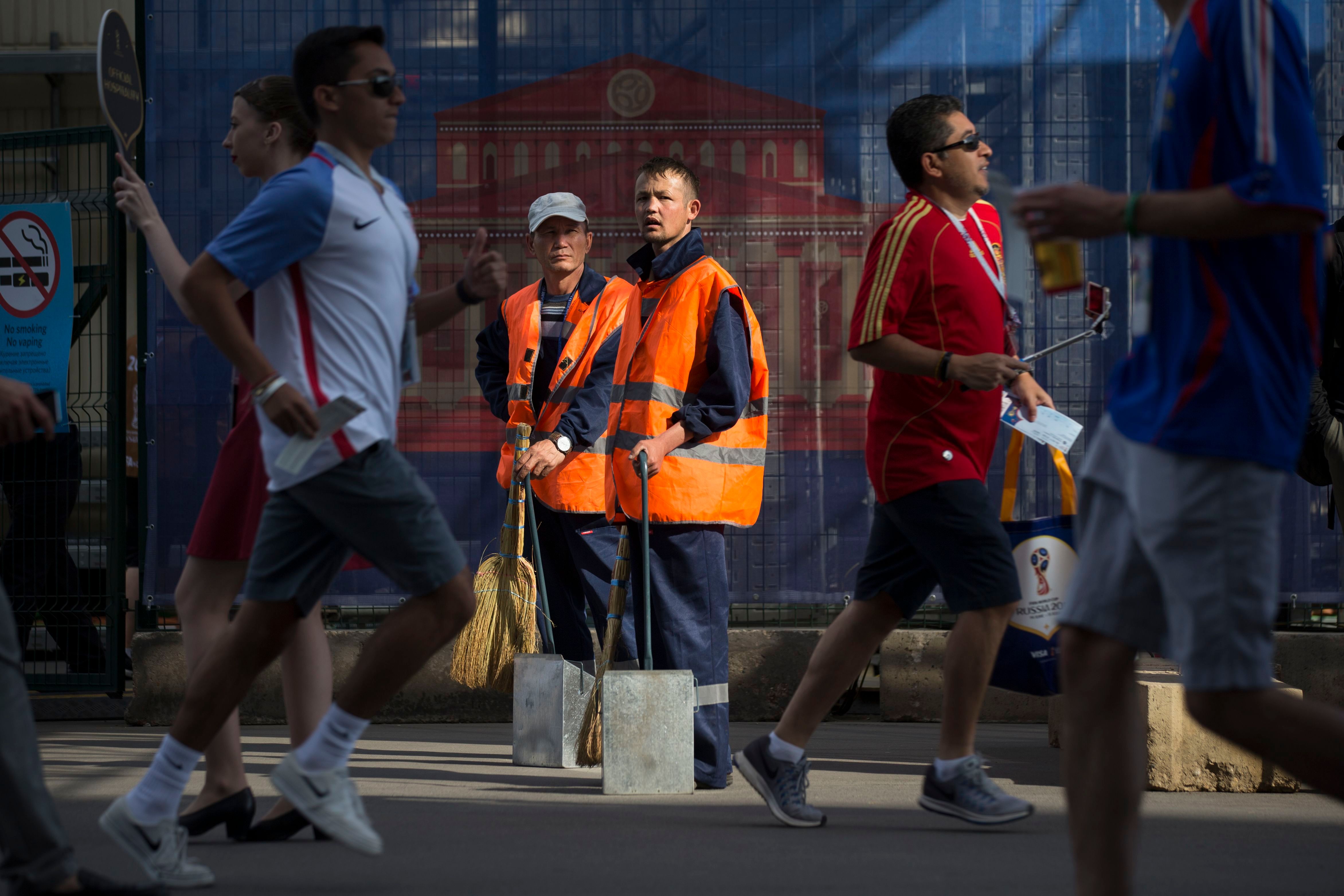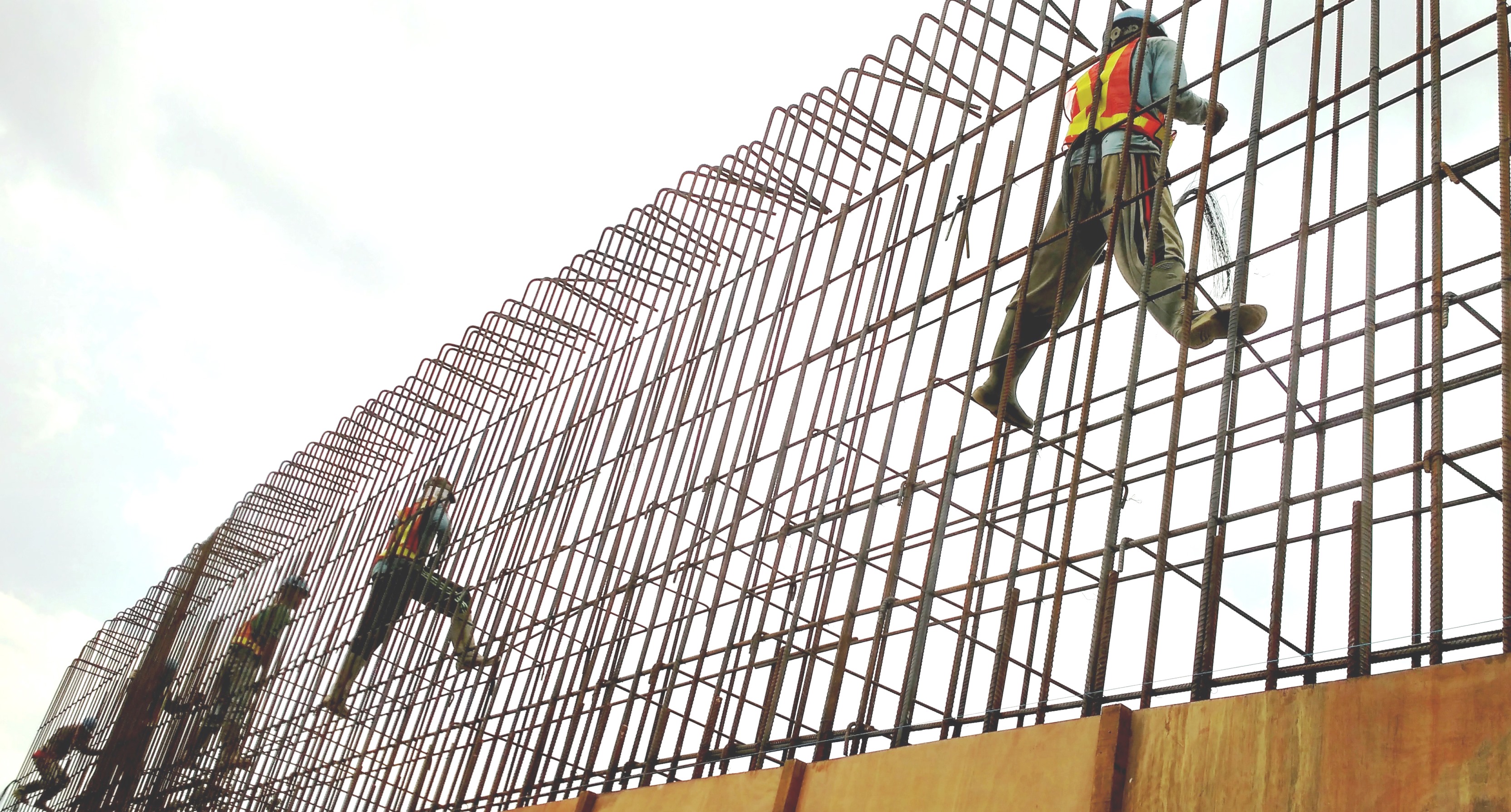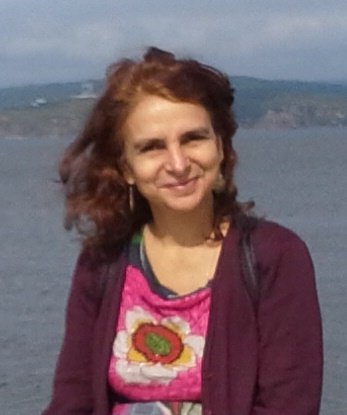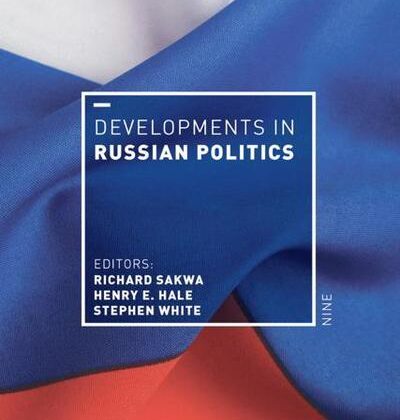
► Russia accepts about four million labor migrants annually, most of them from three Central Asian states. Less noticeable are internal migrant workers—Russian nationals who move to another place to make money, leaving their families behind. Maria Lipman talks to demographer Yulia Florinskaya about the trends, rules, and practices of labor migration in Russia.
Maria Lipman: In Russia, the term “labor migrants” mostly implies those coming from Central Asia. What are other places of origin? What is the scale of labor migration to Russia?
Yulia Florinskaya: In our surveys, especially in the past, people used not to differentiate between “foreigners”—labor migrants coming from abroad—and Russian nationals coming from the North Caucasus; the perception of both groups was essentially the same. These days, at least in large cities, there is an understanding that labor migrants are, first and foremost, those coming from Central Asia. And this is indeed the way it is: 97 percent of all labor migrants coming to Russia are from the Commonwealth of Independent States (CIS), and of these, a majority come from Central Asia: Uzbekistan, Tajikistan, and Kyrgyzstan. As for the scale, Russia accepts about four million labor migrants annually. In summer, this number is higher; come winter, some migrants head home. The overall number ranges from 3.8 to 4.5 million.
Lipman: In recent years, the Russian economy has slowed dramatically. How has this affected the demand for migrant labor?
Florinskaya: Do not forget the demographic factor: we are currently living through a period in which the labor force is shrinking rapidly. The labor force began to decrease in 2007, and in some years of the current decade by as many as 1 million people. By the mid-2020s, the labor force will have shrunk by over ten million people. Russia needs to make up for this loss—by increasing labor efficiency, by increasing the number of employed retirees, and by bringing in labor migrants.
|
“Today those coming from the ‘far abroad’ account for a mere 3 percent, while the remaining 97 percent come from the CIS countries.”
|
Still, in the years since the financial crisis of 2014-15, the number of labor migrants has been on the decline. Keeping track of those who qualify as labor migrants is not easy, because different methods produce different results: official statistics estimate the inflow of migrants based on the number of work permits issued; other estimates are based on surveys, or on migration records. More or less, the consensus is that in peak years (2013-2014), the number of labor migrants reached 7 million. At present, it is down at around 4.5 million. This drop has been mostly at the expense of those from the “far abroad”—that is, China, Vietnam, Turkey, North Korea, and Serbia. There even used to be some inflow of highly qualified and qualified labor from developed countries, from the Baltics.
Lipman: Where are migrants most concentrated?
Florinskaya: The overall number of 4.5 million labor migrants is a small proportion of the 75-76 million people employed. It should also be pointed out that labor migration is very unevenly distributed across Russia. For instance, in the Moscow economy, the proportion is much higher: about 800,000 migrants of the 6.5 million working population.
Unfortunately, few places serve as magnets for labor migrants, whether foreign or internal. Based on the number of labor permits issued, these places are Moscow and the Moscow Oblast, then a much lower number in St. Petersburg and the Leningrad Oblast, Krasnodar Krai, and the northern part of the oil-rich Tyumen oblast (Khanty-Mansi Autonomous Okrug). Some migrants are found in the Sverdlovsk and Novosibirsk regions. There are also labor migrants in the Far East, although their number cannot, of course, be compared to that of the two “capital cities.” But in the Far East, the respective proportions of those coming from the CIS and the “far abroad” are different. For instance, a relatively large number of migrants employed in Primorsky Krai (over half) are from the “far abroad.”
Lipman: What about labor migrants from Ukraine? What impact has the crisis in Russian-Ukrainian relations had on the inflow of migrants from Ukraine?
Florinskaya: Before 2014, because of vague criteria, it was difficult to differentiate labor migrants from others coming to Russia from Ukraine, and there were no reliable statistics. Our rough estimate was that about 1.5 million Ukrainian nationals resided in Russia. Since the military conflict broke out, the inflow has risen abruptly, with most migrants coming from the Donetsk and Lugansk oblasts. Most of those coming from those regions have been granted temporary asylum; they then join the “Compatriots” program and apply for Russian citizenship. Some of them may have found employment, but they do not fully qualify as labor migrants. The number of actual labor migrants has decreased compared to the pre-crisis period. Between 2015 and 2018, we registered a steady decline in labor migration from Ukraine and Moldova. This is easy to explain: Moldova and Ukraine both have a visa-free regime with the European Union that enables them to earn as much or more money than in Russia and even try to gain a foothold in Europe. Those from Central Asia do not have such opportunities.
|
“Between 2015 and 2018, we registered a steady decline in labor migration from Ukraine and Moldova. This is easy to explain: Moldova and Ukraine both have a visa-free regime with the European Union”
|
Lipman: When you interview Ukrainian labor migrants, do you hear complaints of mistreatment since the deterioration in Russia-Ukraine relations?
Florinskaya: Not really. Rather, in our interviews conducted two years ago—that is, after the armed conflict erupted—employers were telling us that they preferred to hire Ukrainians because they were better qualified than migrants from Central Asia. In fact, we heard complaints from local administrators in small towns about those granted temporary asylum: those people behave as if everyone owes them something, the administrators said. As for labor migrants who continue to come from Ukraine, the policy, whether formally or informally, has recently become much tougher; sometimes individuals are simply barred from entering. Those rules that existed but were not necessarily enforced are now applied, sometimes in an unpredictable fashion; exceptions are made only for those coming from Ukraine’s southeast.
|
“We heard complaints from local administrators in small towns about those granted temporary asylum: those people behave as if everyone owes them something, the administrators said”
|
Lipman: What are the most common occupations for migrants? In Moscow, the presence of migrants is quite noticeable among drivers for Uber and similar companies, saleswomen and loaders in supermarkets, servers in fast food restaurants, cleaners, and janitors…
Florinskaya: In our studies, we used to draw on the data submitted by employers: they submitted contracts that stated where those with work permits were accepted. Since the new system of patenty (essentially work licenses with a kind of imputed tax attached, explained in more detail below) has been introduced, such statistics are no longer collected, and we have to draw on surveys. A recent large-scale survey conducted by the Higher School of Economics shows that employment in construction, which used to absorb the largest share of migrant workers, has shrunk as a result of the general decline in the construction industry caused by the economic slowdown. Employment in retail and service sectors has risen, including domestic employment that remains invisible from the outside: housekeepers and caretakers in cities and country houses, nannies, live-in nurses. Not too many now find employment in the transport sector, as the government has tightened requirements for those employed in public transportation. Other occupations include cleaning, housing, and communal services, and working in mobile phone stores or cafes. Of course, I am mostly talking about Moscow. In Khanty-Mansi Okrug, the main industry is the oil production rotation system, which employs both foreign migrants and internal ones.

Lipman: One often hears that, compared to developed countries, in Russia, people rarely move to new places. This is commonly explained by the underdeveloped housing market, which makes it hard for a family to move to a wholly new place. Is that true?
Florinskaya: It is true that the real estate market is underdeveloped. In our studies, we always try to complement the official statistics with our own survey data. We conducted a study of small towns, and then, later, of medium-sized ones. What we found was that the hurdles that used to prevent people from resettling have slowly been eased. For instance, one is no longer fined for unregistered residence. Such fines were a real plague back in the 2000s: even Russian nationals had to hide if they moved from the place where they were registered and lived without a residence registration. Today, one may stay away from the place where one is registered for 90 days, but of course, 90 days can become a lot longer: if stopped, one can say that he or she has just arrived.
Many people do not register at all, and officials look the other way—unless a family wants to enroll their children in school or do something else. If a Russian national applies for a job in another region, the potential employer no longer has the right to ask for his or her residence registration. Sometimes they still do, but this is illegal. Anyone with state insurance that entitles Russian citizens to free, if limited, health care is now eligible for medical treatment covered by that insurance. It used to be that an individual was not eligible if he or she was registered elsewhere. Today, an individual can get a driver’s license in another region, register his or her car there, get married, or apply for a foreign passport. In this sense, there has been some progress. But residence registration practices have not been abolished—they are still in place. They have just stopped being a decisive obstacle for internal migrants. The primary obstacle is indeed the huge difference in real estate prices. If somebody wants to move from a small town to a larger one and, especially, to the capital city, it is the cost of housing that prevents them.
|
“The primary obstacle is indeed the huge difference in real estate prices. If somebody wants to move from a small town to a larger one and, especially, to the capital city, it is the cost of housing that prevents them.”
|
Still, the number of those who resettle has risen, although this is, at least in part, the result of more accurate methods of recording statistical data. Overall, the number of those who move permanently from one region to another [in a given year] is about four million, and this is slowly rising: in 2017, it was 4.2 million, up 1.3 percent compared to 2016. This is about the same level as in southern and eastern Europe, but lower than in the US, Australia, or Canada.
Our studies of small and medium-sized towns and the data that Rosstat (the Russian government statistics agency) began to collect in 2012 on those Russians who work away from their permanent residence produced knowledge on those who move to another place to make money, leaving their families behind. These people are also labor migrants, but internal ones. Rosstat’s estimate is two million, but our own studies suggest that this number is significantly higher. One of the reasons for this is that Rosstat takes into account only those who find employment in another region, while people may find employment far from their homes within their own region (and some Russian regions are fairly large). Our conservative estimate is 2.5-3 million. We believe—and Rosstat tends to agree—that an individual qualifies as a “migrant” if he or she works away from home and stays there at least for one week on end. This rotation system of employment is not a specifically Russian phenomenon—it also exists for crab catching in Alaska, for instance.
Lipman: But in Russia, the rotation system is not limited to oil production, correct?
Florinskaya: In our study of medium-sized cities, about 30 percent of those working away from their homes had higher education, and one in five (a higher share than among foreign migrants) found jobs requiring these qualifications. Some of those with higher education had to take underqualified jobs, for instance as guards. These internal migrants are employed in construction, retail, and real estate, and in households as nannies and live-in nurses taking care of the elderly and disabled.
|
“About 30 percent of those working away from their homes had higher education, and one in five (a higher share than among foreign migrants) found jobs requiring these qualifications.”
|
Lipman: When individuals work on such a rotation scheme, where they are away from home for a week or longer, do their earnings count toward their pension?
Florinskaya: This depends on whether the employment is formally registered or remains “in the shadow.” In our study of small towns, we asked people whether they had formal contracts. It turned out that individuals who remained at home were just as likely to be engaged in shadow employment as those who left to work as internal migrants. That is, non-pensioned employment did not depend on the job location. This is different in large cities: labor migrants in Moscow are more likely to have “shadow jobs” than employed Muscovites. But this depends on the specific job: labor migrants working in the transport sector are always registered, just as Muscovites are. In construction, some are registered and some are not. Those working in households almost never have official contracts.
Lipman: How is the situation of foreign migrants different from that of internal ones? The housing conditions of those who work away from their families for a week or longer are presumably not much better than those of foreign migrants. And what about payment—do they get equal pay?
Florinskaya: Many problems are similar for both categories. Housing conditions are often equally hard. Construction workers, both foreign and domestic migrants, live in shacks. Both categories work very hard and are extremely thrifty, saving on everything, including leisure, so that they can provide as much as possible for their families. Health care is where they differ. Foreign migrants have to pay for everything; even though they buy insurance, few can actually use it. But Russian nationals can now get health care where they happen to be; as I already mentioned, this hurdle has been removed. And of course, it is easier for Russian migrants to take care of the necessary formalities. That is why shadow employment is more common among foreign migrants than among internal ones. As for compensation, foreigners typically work longer hours for the same pay. And, most importantly, foreigners face problems with migration registration, patenty, etc., while internal migrants, of course, do not face such administrative hurdles.

Lipman: Would you explain the patenty system in more detail?
|
“Foreign migrants have to pay for everything; even though they buy insurance, few can actually use it.”
|
Florinskaya: This system was introduced in 2010 solely for migrants from the CIS hired by individuals or families to work in their households. The idea was that those employed by companies or enterprises pay taxes, while those who work in households as nannies, drivers, caretakers, etc., do not, therefore they should pay a special tax up front. The new tax was levied only on foreigners, no matter that Russian nationals doing the same jobs don’t pay taxes either. At that time, it was very difficult to get a work permit, which made corruption ubiquitous. When the new tax was introduced, it was very low—1100-1200 rubles per month. One paid this money, was granted a license (called patent), and could rest easy. After a while, it was common for labor migrants to buy these licenses. In 2014, 2.4 million licenses were issued. Later on, this practice was extended to those hired by legal entities. Every CIS citizen seeking employment in Russia has to buy a patent, and the price has been rising by the year. In 2018 in Moscow, it reached 4,500 rubles (about $70) per month.
|
“Another requirement is a Russian language test—all experts were against this measure, because it has been reduced to a mere payment for grades.”
|
The new system is not bad and it is reasonably transparent: you come to Russia, register as a labor migrant, get an individual taxpayer number, and buy medical insurance. Another requirement is a Russian language test—all experts were against this measure, because it has been reduced to a mere payment for grades. Also, Moscow has opened a very good center, albeit located rather far away, where migrants can take care of all the formalities in one place. An individual is charged a one-time payment of 16-18,000 rubles plus the monthly patent. For migrants hired by private individuals to work in their households, this payment is their contribution to the Russian economy, regardless of whether they are actually employed. For the government, this is a substantial monetary contribution: in 2017, 51 billion rubles was paid to regional budgets. In addition, many migrants pay actual taxes, pay rent, buy food, etc. That is, some of the money they earn stays in Russia.
Lipman: In your articles, you have pointed out that internal labor migration may have a positive impact on the national economy as a whole…
Florinskaya: In our discussions with local administrators, they often complain about their residents going elsewhere in search of employment instead of working in their own regions and paying taxes there. They tend to forget that they send about three-quarters of their earnings to their families, who go shopping, pay for medical treatment, buy and renovate their apartments, etc. My colleague Nikita Mkrtchyan estimated that the total remittances transferred to families by the millions of Russian nationals working away from home is comparable to the remittances transferred abroad by migrants from the CIS countries. These “internal remittances” may be regarded as a redistribution of sorts. Those individuals who cannot find employment in their own municipality, town, or city find it elsewhere. This is, of course, not an easy life, because families are left behind and children and parents seldom see each other. But at least this is a life strategy that individuals have found for themselves. It is similar to the shuttle traders of the 1990s, who can also be described as labor migrants. The number of labor migrants today is sometimes hugely overestimated—one comes across numbers such as 20 million. In our opinion, this is nonsense; the actual number is comparable to those who move permanently to new places of residence.
|
“The total remittances transferred to families by the millions of Russian nationals working away from home is comparable to the remittances transferred abroad by migrants from the CIS countries.”
|
Lipman: In your publications, you use the word “equalization” to describe the economic effect of internal migrants.
Florinskaya: Yes, I think that regional inequality is somewhat mitigated by migrant workers’ remittances. When families stay behind, they spend in their region the money earned in another region by the migrant family member. Thanks to internal labor migration, some young people stay home and children go to school there. From this standpoint, labor migration is not a bad thing. There is always talk about those who come from the Moscow Oblast to work in Moscow and pay taxes there instead of at home, but they still spend their earnings in the Moscow Oblast, in the places of their permanent residence.
Lipman: In your opinion, has the government’s migration policy improved in recent years?
Florinskaya: My colleagues working in this field, including myself, were strongly in favor of introducing patenty. However, the problem is not that the existing rules are bad. Rather, the problem is the absence of a general strategy. On the one hand, patenty have been introduced, which has made the system more transparent, but on the other, migration registration gets tougher all the time. For instance, our surveys invariably show that those who rent space to migrants never register their tenants. This makes things more complicated, leading to fictitious registration in fictitious apartments and, of course, corruption. My colleagues and myself have proposed many times that migrants be allowed to register not in their rented apartments, but in the offices where they get their patenty. But this system is insurmountable, and it only gets tougher. There is also a rule that if a migrant commits two administrative infractions, he or she is barred from re-entering Russia. Those infractions may be truly minor, such as jaywalking or smoking where it is prohibited. And even if a migrant has paid his or her fines, he or she is still barred from reentering. We have been trying very hard to persuade the authorities to get rid of this rule, but to no avail. Another example has to do with the very obscure system of issuing residence permits. Those individuals who have worked in Russia for many years, are perfectly law-abiding, and have their patent and all other formalities in order may want to settle down, but there is basically no mechanism for transitioning from temporary migrant status to long-term status; legal work for many years and full payment of taxes do not make an individual eligible for a residence permit.
|
“There is basically no mechanism for transitioning from temporary migrant status to long-term status; legal work for many years and full payment of taxes do not make an individual eligible for a residence permit.”
|
The Interior Ministry has recently come up with a bill that would give breaks to certain categories. For instance, those with a Russian college degree or who have graduated from Russian vocational schools will be assured of long-term residence permits. Another novation applies to migrants whose qualification is on the Ministry of Labor’s forthcoming list of desired professions. According to the bill, such migrants will be granted residence permits after they have worked for six months, their employers have paid contributions to the Pension Fund for them, etc. (Today, it does not make a difference whether one is qualified or not; all migrants have to buy a patent.) As you see, there is some progress. It is certainly a good thing that such a bill has been written, yet it is only a bill, not a law, and nobody knows when or if it will be adopted. It should be noted, however, that local law-enforcement practices are not infrequently—in fact, very often—in conflict with the law.
Yulia F. Florinskaya, Leading Researcher, Institute for Social Analysis and Prediction (INSAP), Russian Presidential Academy of National Economy and Public Administration (RANEPA).


Top image: Shutterstock 9735833a. Following images: Pxhere











